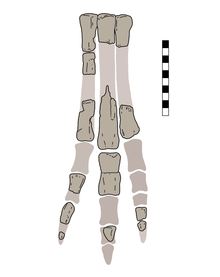| Imperobator Temporal range: Late Cretaceous (Maastrichtian)
| |
|---|---|

| |
| Left hind limb and full body reconstruction | |
| Scientific classification | |
| Domain: | Eukaryota |
| Kingdom: | Animalia |
| Phylum: | Chordata |
| Clade: | Dinosauria |
| Clade: | Saurischia |
| Clade: | Theropoda |
| Family: | †Dromaeosauridae |
| Subfamily: | †Unenlagiinae (?) |
| Genus: | †Imperobator Ely & Case, 2019 |
| Species: | †I. antarcticus
|
| Binomial name | |
| †Imperobator antarcticus Ely & Case, 2019
| |
Imperobator ("powerful warrior") is a genus of probable unenlagiid paravian theropod dinosaurs, that lived during the Maastrichtian age of the Late Cretaceous in what is now James Ross Island in Antarctica. Imperobator is one of only two non-avian theropods known from Antarctica, crossing over to the landmass when it was part of Gondwana. The only described specimen was found in 2003 by an expedition launched by the University of California Museum of Paleontology and initially described as a dromaeosaur in 2007. The fossil was formally described as a new genus in 2019, and later searches reported more fossils from the site including teeth and skull bones.
It was initially suggested that Imperobator may be one of the largest known paravians, comparable in size to gigantic dromaeosaurids such as Utahraptor and Austroraptor, but subsequent anatomical revisions suggested a body length similar to that of Neuquenraptor and Deinonychus. Because the preserved material appeared to lack the characteristic "sickle claw" of dromaeosaurs on the second digit, Imperobator was initially classified as a basal paravian of uncertain affinities, though later researchers found support for unenlagiine affinities.
It was discovered in the Cape Lamb Member strata of the Snow Hill Island Formation, which bears a variety of other fossils, many of them unique as they evolved in the isolation of Antarctica after the breakup of Gondwana. Imperobator coexisted with the ornithopod dinosaur Morrosaurus and bird Antarcticavis in addition to a menagerie of mosasaurs, plesiosaurs, and a pterosaur.